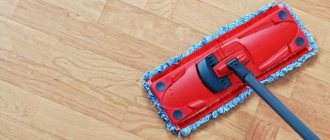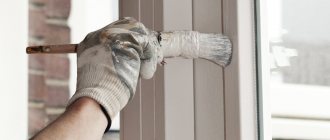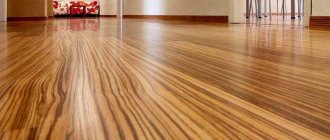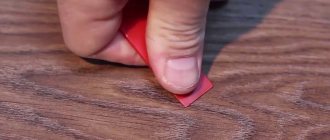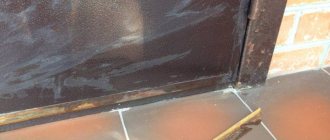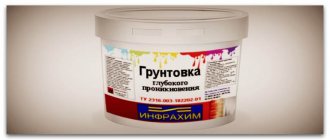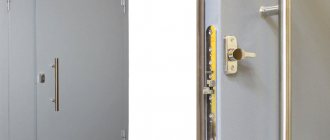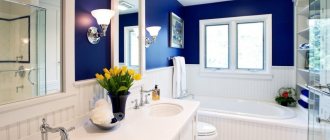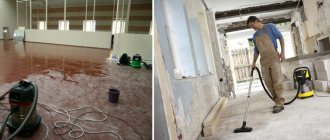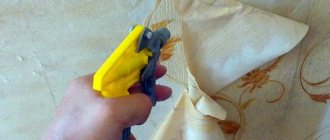It's a great joy when a renovation comes to an end. But there are always still small nuances that spoil the mood.
One of them is a dirty floor; it still needs to be cleaned of construction marks. Keep in mind that getting the floor to perfect condition will be difficult.
How to clean floors after renovation? To prevent white stains from reminding you of repair work, learn about the most effective methods and means for washing.
How to make cleaning easier after renovation?
How to clean whitewash from floors? There is a very practical belief that it is better to prevent a problem than to correct the consequences. To reduce the risk of coating contamination, do the following before starting work:
- Cover the floor with oilcloth or polyethylene.
- Attach it to the baseboards with masking tape.
Note: If this material is not available, use old newspapers or scrap rags.
These measures will help reduce the degree of contamination, but, unfortunately, painting dust will still settle on the surface over time, and the glue will leave sticky stains.
If you haven’t taken care of timely protection at all, then long-term cleaning is guaranteed. But even in this case, do not despair! In this article, we will give you some effective tips and recommendations on how to quickly clean a floor made of any material after renovation, without spending a lot of time and effort cleaning your home.
How to clean the floor after renovation?
How to wash or clean concrete dust? To cope with such a difficult task as quickly as possible, you will need the following tools:
- water container;
- several rags;
- microfiber cloths;
- vinegar;
- salt;
- potassium permanganate;
- ammonia;
- kerosene;
- dishwashing detergent;
- Domestos;
- LOC Liquid Organic Cleaner from Amway;
- special floor cleaning products Mister Muscle and Mister Proper;
- laminate and parquet care products, for example, Laminate wash & shine;
- tile care products, for example, HG “Polish, wax and dirt remover”;
- Acidic floor cleaner DETERDEK.
In a separate article you will find a more detailed selection of suitable cleaning products after renovation.
How to clean an apartment after renovation and white residue on the floor?
The general outline of your cleaning actions will look like this:
- Clear the area for cleaning: remove furniture and belongings.
- Use a damp broom to collect large debris into trash bags.
- Sweep or vacuum the floor to remove dust.
- Use a cloth soaked in warm water to wash off any major dirt.
- Let the base dry.
- If there are stuck pieces of cement, putty, or whitewash on the floor, take a spatula and carefully try to scrape off the top layer of such stains.
- Wet the remaining marks thoroughly with water to acidify them, then carefully remove them with a rag.
- Start mopping the floor from the far corner towards the exit using a raking motion.
- Rinse the mop (rag) thoroughly and often.
- Twist the rag well so as not to apply excess moisture to the decorative coating.
- Change the water in the bucket as often as possible.
Note: Having tidied up the walls, think about their further design. We will give you many DIY wall decor ideas.
The main causes of parquet contamination
Dirty parquet looks untidy and deteriorates over time.
A dirty floor spoils the appearance of the room. Stains on it reduce the strength and quality, which leads to rapid wear of the coating.
The floor usually gets dirty for the following reasons:
- Moisture _ Stains on parquet flooring are caused by liquid spilled on it. An increased level of humidity in a room negatively affects its appearance.
- Pets . Cats and dogs can damage the coating with their claws or go to the toilet directly on the parquet.
- Furniture items . Even if they don't move, the floor is damaged by the weight of large cabinets, sofas and other bulky items.
- Shoes. Heels and especially stiletto heels easily scratch wood flooring.
If you do not clean the parquet floor on time, dust, dirt and sand soon eat into the structure of the wood and cause the development of microbes.
How to clean the floor from construction dust?
There are several ways to clean whitewash from a floor, all of them have been tried and tested by more than one specialist. Choose the one that is more suitable for you depending on the type of decorative covering on the floor.
Method 1
To wash off traces of whitewash from the floor, use vegetable oil:
- Make an oil solution in a bucket of warm water in a ratio of 1:100.
- Wash the floor thoroughly.
- Replace the water, add 100 grams of vinegar to it.
- Rinse with this solution.
- Rinse off the solution with clean water.
Note: Vinegar can be replaced with any chlorine-containing product.
Method 2
To clean limescale, use regular kitchen salt:
- For the first time, wash the floor with a warm solution of water and dishwashing detergent: 1 tbsp. funds for a bucket of water.
- Second time with a salt solution: add ½ cup of salt to a bucket of water.
- If traces of whitewash still remain, add 100 ml of table bite to the saline solution.
- Finish the process by wiping with clean water.
Method 3
If the contamination is very serious, use potassium permanganate:
- Dilute potassium permanganate in water until it turns bright pink.
- Wipe the floor with the solution.
Note: Do not use this method on varnished surfaces - streaks will remain.
Method 4
Dirt that has become ingrained after repairs can be easily washed off using kerosene:
- Add 100g of kerosene to a bucket of water.
- Wash the floor.
- To remove the smell, dilute 200 ml of vinegar in a bucket of clean water.
- Wipe the floor with the solution.
Method 5
To remove old whitewash from the floor, use Domestos Pine Fresh universal cleaner:
- Dilute the product in water in a ratio of 50 ml per 5 liters of water.
- Wash the floor with the solution.
- Wipe the surface several times with clean water.
Method 6
To deal with stains after repairs, use special detergents designed for floors: Mr. Proper and Mr. Muscle. They will make your floor clean and fill the room with fresh aromas. They can be diluted in water and not removed from the decorative coating additionally after the main wash with clean running water.
Note: Please read the instructions carefully before use to ensure correct proportions.
Method 7
This product is suitable for all floor coverings - a universal concentrate from Amway LOC:
- Pour water into the container.
- Add concentrated product to it in a ratio of 1:200.
- Wash the floor with the solution.
- No need to rinse off.
- Repeat the process if necessary.
Method 8
Use a special product designed for cleaning gypsum dust PROBEL; it is also recommended for cleaning whitewash works. It is sold in all hardware and construction stores.
Apply it like this:
- Dilute 10 ml of product per 1 liter of water.
- Apply to coating.
- Rinse with water.
Washing tiles and porcelain tiles
Cleaning a tiled floor after renovation work is much easier than other coatings. The tiles will not be damaged by hard sponges and brushes. It can be treated with any detergents, vinegar, soda ash and citric acid. The same can be said about porcelain stoneware. It is wiped with dilute acids and solvents, if necessary. The main thing is that the caustic agent does not get into the seams. After such treatment, the floors must be thoroughly washed with clean water.
Regardless of whether your floor is tile, laminate or parquet, cleaning the flooring after renovation work will be very difficult. Especially if you do not do cleaning work professionally. Therefore, it is better to order cleaning of premises after renovation from our company in order to quickly get high-quality results and avoid damage to materials.
How to wash the floor after painting?
If you have a painted wooden floor, use a solution of water and ammonia:
- For 1 liter of water add 1 tbsp. ammonia.
- Wash the floor with this solution.
- If you want the wooden surface to shine, additionally wipe with a cloth soaked in linseed oil.
To remove paint stains from a painted floor, use alcohol:
- Soak a cotton swab in alcohol.
- Apply to the stain for a few seconds.
- Take a spatula and carefully peel off the paint.
Note: If the paint stains are extensive, dilute ammonia in water and rub the contaminated areas.
For high-quality cleaning of whitewashed floors, use DETERDEK acid floor cleaner. It removes construction dirt and limestone traces from all surfaces.
The principle of its application is as follows:
- Dilute, depending on the degree of contamination, in a ratio of 1:5 to 1:10.
- Spread the substance over the floor using a rag.
- Leave for a few minutes
- Rinse off with plenty of water.
Note: To restore shine and shine to the old coating, wash it with a mixture of milk and water in a 1:1 ratio.
Folk remedies for parquet floors
Grease stains on parquet need to be sprinkled with starch or talcum powder so that the grease is absorbed.
You can wash parquet floors and remove different types of stains from it using home remedies. They are cheaper and more accessible than ready-made chemicals.
A few simple recipes:
- White clay . Will restore shine and newness to the coating. The clay is mixed with water until a thick paste is obtained. The mixture is spread on the floor surface and left for some time. After this, it is carefully removed with warm water.
- Starch . It will help remove greasy stains from parquet and other stubborn stains. The powder is poured onto the oil trail, a napkin is placed on top and ironed.
- Ammonia . A universal product that will efficiently remove stains from tea, coffee, and blood. It will restore shine to the parquet, remove scratches, and make the floor smooth.
You can eliminate black streaks from shoes without any chemicals, using nylon fabric. So don't throw away your old tights and stockings - they may come in handy for cleaning.
How to clean linoleum after repair?
All of the above methods are suitable for linoleum-covered floors. Let's add a few more useful tips on caring for this decorative material.
Note: When cleaning linoleum, do not use such products as ammonia, gasoline and alcohol.
Method 1
Dirty embossed linoleum is much more difficult to clean, unlike other types. It is ideally washed with a massive washing vacuum cleaner. With this approach, you can easily clean the coating from whitish spots.
Method 2
To return linoleum to its original appearance if it has darkened, use drying oil:
- Apply the product to a rag.
- Wipe the coating thoroughly.
- Rub with a dry woolen cloth.
How to clean a laminate floor after renovation?
Laminate is a very common type of coating these days. The laminated board is covered with a thin layer of fibrous material impregnated with thermosetting resins. This makes it heat-resistant, impact-resistant, and resistant to long-term loads, but, despite all these qualities, it requires careful handling and some care.
Option 1
The easiest way is to use a solution of water and vinegar:
- Dilute vinegar in a bucket in a ratio of 1 tbsp per 5 liters of water.
- Wipe the surface with this solution.
- Rinse off with clean water.
Option 2
Use special laminate care products - they wash and add shine to the coating, and also have a fresh smell:
- Make a solution in the proportion of 100 ml of Laminate wash & shine to 10 liters of warm water.
- Wash the surface with this solution using a microfiber cloth; it absorbs moisture well and cleans perfectly.
- Make sure that the rag is not very wet to avoid deformation of the coating.
Note: do not wash off the solution.
How to make the floor less dirty
If the parquet is often walked on, it is better to cover it with a carpet.
Compliance with preventive measures will preserve the beauty of the parquet longer and delay the time of the next repair.
It is better to cover the floor in rooms where people often walk and greet guests with carpet to protect it from damage and dirt. Glue felt pads to furniture legs so that they do not leave scratches while moving.
Wood does not like dampness, so the humidity level should not be higher than normal, otherwise the parquet board will begin to swell and mold will appear underneath it. But too dry air is also harmful: it will cause the floor to crack.
You should not walk around the apartment in street shoes, so as not to dirty the floor again. Dirt eats into the wood and is difficult to remove.
Parquet boards are considered a safe flooring material. It has a beautiful texture, gives the room a unique style, and does not emit harmful substances into the air. But parquet floors need proper care to ensure they are always clean and free of stains and streaks.
How to clean parquet after renovation?
Parquet boards are afraid of moisture, so it is not recommended to wash parquet; usually it is wiped with a barely damp cloth. But if there is such a need, use special parquet care products for cleaning. For example, Parquet wash & shine. This product is used for varnished parquet.
When cleaning, follow this sequence of actions:
- Vacuum the surface with a special attachment that has soft wheels.
- Make a solution of 100 ml of product per 10 liters of warm water.
- Soak a regular floor cloth in the solution or use a special HG “Natural fiber floor cloth” cloth.
- Before mopping the floor, wring out the cloth and make sure it is not very wet.
- Wash the floor.
- After treatment, do not rinse or dry the surface - the product covers the floor with a special film and gives the surface shine.
In order to remove paint stains from parquet without a varnish coating, we offer several options:
- Option 1: Use regular cream.
- Apply the cream to a rag.
- Gently rub the stain.
- Try some cologne.
Parquet cleaning
Before you wash the parquet after repair, you must first find out what type of contamination you are dealing with - the method of cleaning the surface will depend on this.
Common water-soluble dirt (putty, whitewash) can be removed with plain water and a small amount of detergent. That is why special preparation and long thoughts about how to wash putty from the floor are not required. In addition, the use of water to wash away dirt in the case of parquet is also justified for the reason that parquet is not afraid of moisture and is excellent for wet cleaning.
It will be much more difficult to deal with paint or glue that gets on the parquet.
Here you will have to use the following recommendations:
- Solvents are used to remove serious stains, but it is necessary to act with extreme caution: solvents can damage the top layer of parquet and thereby render it unusable;
- It is best to use soft compounds - white spirit, kerosene, methyl alcohol or substances for caring for stoves;
- To wash off dirt, a small amount of solvent is applied to the dirt and rubbed, and the sooner this is done, the easier it will be to remove the stain;
- Before eliminating contaminants, it is better to test how the solvent will act on a small, inconspicuous area of the coating.
In addition to methods for washing dirt on parquet, you need to know what methods of exposure to this floor covering are prohibited:
- Parquet cannot be cleaned using rough brushes and metal scrapers: these devices can damage the varnish layer, thereby completely ruining the coating;
- When wet cleaning, you need to monitor the amount of water used: parquet can be washed, but an excessive amount of water can render it unusable;
- Detergents containing abrasive particles or aggressive solvents cannot be used to wash parquet flooring - its surface is not designed to withstand such loads.
How to clean floor tiles after renovation?
To remove lime deposits from tiles, use a special HG “polish, wax and dirt remover” tile care product.
Note: It protects the floor from the appearance of new stains and greatly simplifies the cleaning process.
The way to use it is very simple:
- Dilute 100g of product into 10 liters of water.
- Wash the floor, constantly rinsing the cloth.
- Change the water when it gets dirty.
- Do not rinse the floor to avoid removing the layer of shine.
Useful tips
- To achieve a good result in cleaning whitewash from the floor, try to change the water more often.
- Do not let the paint dry on the surface, try to remove it immediately.
- When using strong-smelling products, work in a well-ventilated area.
- Work in special clothing and protective gloves.
By adhering to the above rules for cleaning after renovation, you will be able to enjoy the work you have done to change the interior design and relax peacefully in a cozy home, rather than spending a lot of time on lengthy cleaning of all traces!
Features of different surfaces
Small debris quite often causes a lot of difficulties after repairs. It gets stuck in cracks and can form hard deposits when wet.
Processing is complicated by the fact that different methods are used for each coating, and incorrect selection of materials can cause great harm.
Also, before starting, all furniture, tools and auxiliary materials are removed, thereby clearing the field for activity.
